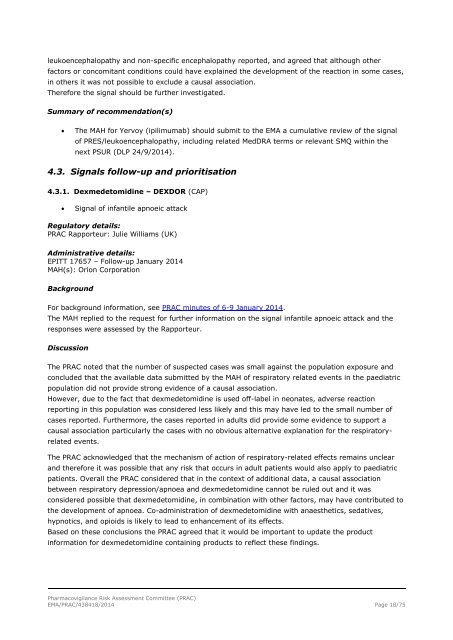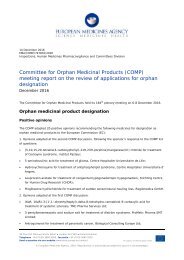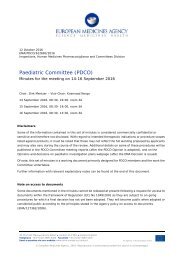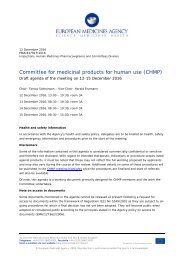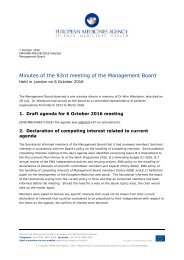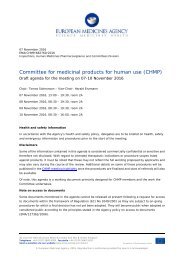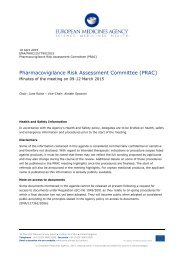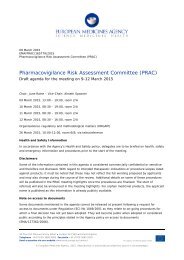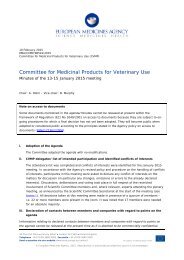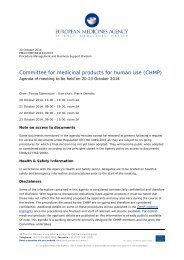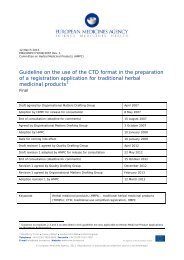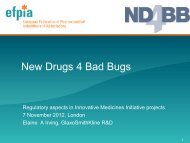1u7kf0g
1u7kf0g
1u7kf0g
You also want an ePaper? Increase the reach of your titles
YUMPU automatically turns print PDFs into web optimized ePapers that Google loves.
leukoencephalopathy and non-specific encephalopathy reported, and agreed that although other<br />
factors or concomitant conditions could have explained the development of the reaction in some cases,<br />
in others it was not possible to exclude a causal association.<br />
Therefore the signal should be further investigated.<br />
Summary of recommendation(s)<br />
<br />
The MAH for Yervoy (ipilimumab) should submit to the EMA a cumulative review of the signal<br />
of PRES/leukoencephalopathy, including related MedDRA terms or relevant SMQ within the<br />
next PSUR (DLP 24/9/2014).<br />
4.3. Signals follow-up and prioritisation<br />
4.3.1. Dexmedetomidine – DEXDOR (CAP)<br />
<br />
Signal of infantile apnoeic attack<br />
Regulatory details:<br />
PRAC Rapporteur: Julie Williams (UK)<br />
Administrative details:<br />
EPITT 17657 – Follow-up January 2014<br />
MAH(s): Orion Corporation<br />
Background<br />
For background information, see PRAC minutes of 6-9 January 2014.<br />
The MAH replied to the request for further information on the signal infantile apnoeic attack and the<br />
responses were assessed by the Rapporteur.<br />
Discussion<br />
The PRAC noted that the number of suspected cases was small against the population exposure and<br />
concluded that the available data submitted by the MAH of respiratory related events in the paediatric<br />
population did not provide strong evidence of a causal association.<br />
However, due to the fact that dexmedetomidine is used off-label in neonates, adverse reaction<br />
reporting in this population was considered less likely and this may have led to the small number of<br />
cases reported. Furthermore, the cases reported in adults did provide some evidence to support a<br />
causal association particularly the cases with no obvious alternative explanation for the respiratoryrelated<br />
events.<br />
The PRAC acknowledged that the mechanism of action of respiratory-related effects remains unclear<br />
and therefore it was possible that any risk that occurs in adult patients would also apply to paediatric<br />
patients. Overall the PRAC considered that in the context of additional data, a causal association<br />
between respiratory depression/apnoea and dexmedetomidine cannot be ruled out and it was<br />
considered possible that dexmedetomidine, in combination with other factors, may have contributed to<br />
the development of apnoea. Co-administration of dexmedetomidine with anaesthetics, sedatives,<br />
hypnotics, and opioids is likely to lead to enhancement of its effects.<br />
Based on these conclusions the PRAC agreed that it would be important to update the product<br />
information for dexmedetomidine containing products to reflect these findings.<br />
Pharmacovigilance Risk Assessment Committee (PRAC)<br />
EMA/PRAC/438418/2014 Page 18/75


